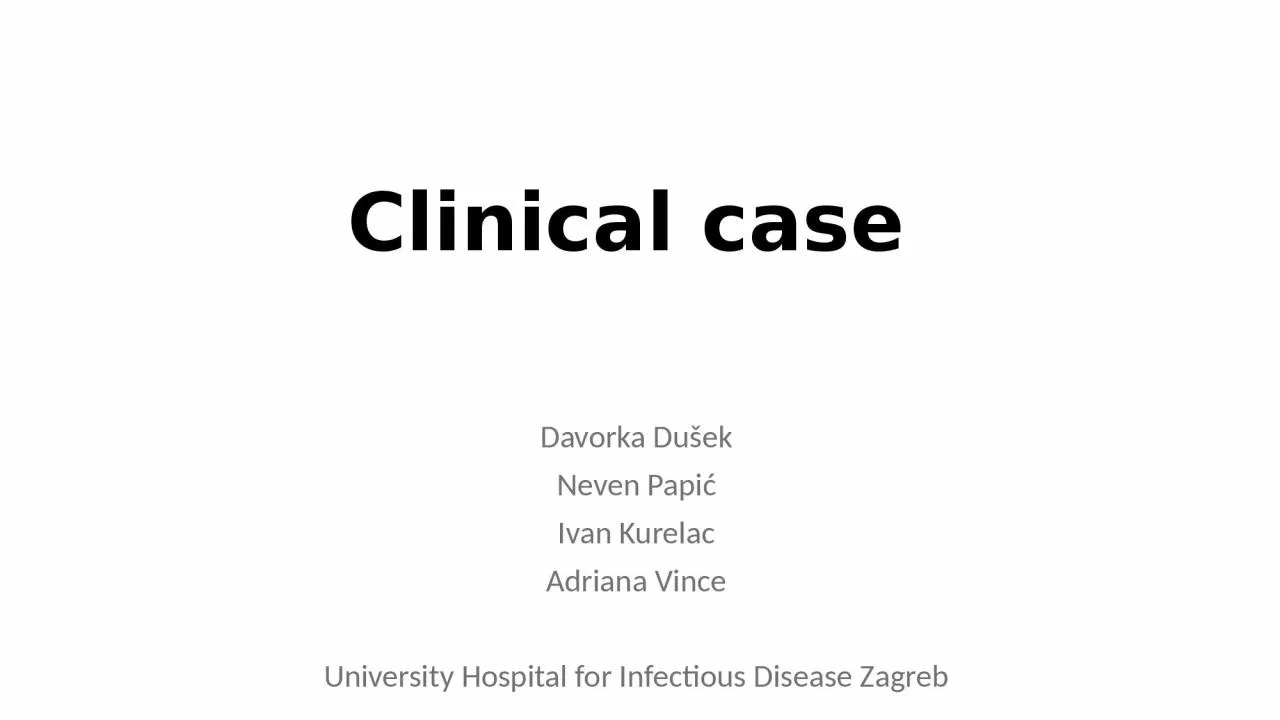

Dušek Neven Papić Ivan Kurelac Adriana Vince University Hospital for Infectious Disease Zagreb History Male patient 29 years Hospitalized in UHID from 12 th 19th February ID: 931233
Download Presentation The PPT/PDF document "Cl inical case Davorka" is the property of its rightful owner. Permission is granted to download and print the materials on this web site for personal, non-commercial use only, and to display it on your personal computer provided you do not modify the materials and that you retain all copyright notices contained in the materials. By downloading content from our website, you accept the terms of this agreement.
Slide1
Clinical case
Davorka
Dušek
Neven
Papić
Ivan Kurelac
Adriana
Vince
University
Hospital
for
Infectious
Disease
Zagreb
Slide2History
Male patient, 29 years
Hospitalized in UHID from 12
th
-
19th
February
2018
Slide3Current illness
Admitted on the 7th day of
current
illness
First 6 days fever 37.5-38
°C
with chills, malaise and headache
On the 4th day noticed darker urine
On the 5th day noticed jaundice
Complains of nocturnal pruritus
No abdominal pain, vomiting, rash, arthralgia
Rarely coughs, no sore throat
Medications: acetaminophen up to 3 gr/daily
Slide4History
Previous
illnesses
:
-
in
2015 had
acute
hepatitis E
-
from
2016
nonalcoholic
steatohepatitis
(FS 6.2
kPa
, CAP 300 dB/m)
Medications
: none
Social
history
:
denies
smoking,
illicit
drug use,
any
herbal
or OTC
medications
;
alcohol
-
occasionally
;
works
in
a
brewery
Epidemiologic
history
:
lives
in
Zagreb
with
his
parents
, no
sick
contacts
,
recent
travel
to Dubrovnik, no
animal
contact
,
denied
transfusion
Vaccination
: HBV
No
allergies
Slide5Physical examination
BP 110/70 mmHg, pulse 86/min, RR 16/min, T 36.9
°C
Alert
,
oriented
,
malaised
Meningeal
signs
negative
Skin
and
sclerae
icteric
, no
rash
or
bleeding
Throat
:
slightly
erythematous
, no
exudate
Lymph
nodes
:
right
angular
region
1-2 cm,
non
tender
Abdomen:
soft
,
non
tender to
palpation
,
liver
1 cm, spleen 3 cm
Heart
,
lungs
,
extremities
-
unremarkable
Neurological
examination
-
unremarkable
Slide6Laboratory results from GP
E 5.00,
Hb
152, MCV 87, WBC 11, ne 39,
ly
50,
mo
8,
eo
2,
Plt
110
CRP 18.6
Bilirubin 160, AST 139, ALT 230, GGT 629, AP 535,
amylase
73
Slide7Initial laboratory evaluation
of
liver
injury
Hepatocellular
enzymes
: AST, ALT
Cholestatic
markers
: AP, GGT
Excretory
function
: bilirubin
Synthetic
function
: PT,
albumin
Slide8Patterns of liver
tests
abnormalities
Hepatocellular pattern
:
•
Disproportionate
elevation in
ALT/AST
compared with
AP
•
Serum
bilirubin may be elevated
•
Tests
of synthetic function may be abnormal
Cholestatic pattern
:
•
Disproportionate
elevation in the
AP
compared with
ALT/AST
•
Serum
bilirubin may be elevated
•
Tests
of synthetic function may be abnormal
Isolated hyperbilirubinemia
Slide9Slide10Slide11Cholestatic liver lesion
Marked
elevation
of
AP (>4
times
)
●
Obstructive
jaundice due to cancer
●
Bile
duct stones
●
Sclerosing cholangitis (primary or secondary)● Bile duct stricture● Drug and toxins associated with cholestasis● Primary biliary cholangitis● Liver allograft rejection● Infectious hepatobiliary diseases seen in patients with AIDS (eg, cytomegalovirus or microsporidiosis and tuberculosis with hepatic involvement)● Infiltrative liver disease (eg, sarcoidosis, tuberculosis, metastatic malignancy, amyloidosis)● Alcoholic hepatitis (rarely)
Moderate
elevation
of
AP
viral
hepatitis
chronic
hepatitis
c
irrhosis
infiltrative
diseases of the liver
congestive
heart failure
Hodgkin
lymphoma
myeloid metaplasia
intra-abdominal
infections
Slide12Differential
diagnoses
?
Further
procedure?
Diagnostic
workup
?
Slide13Laboratory results on admission
E
5.08
,
Hb
153
, MCV
88.4
,
WBC
12.3
, ne
20
,
ly
41
, reactive ly 28, mo 10, plasma 1, Plt 110CRP 19.1Glucose 5.4, urea 5.5, creatinine 112, Na 135, K 4.1, Cl 93Bilirubin 195 (conj 108), AST 142, ALT 234, GGT 617, AP 663, LDH 627PT 1.01, INR 0.98, fibrinogen 4.8TP 77, alb 44 g/l (alb 57.1-alfa1 4.3-alfa2 8.4-beta 11.7-gamma 18.5%)
Slide14Abdominal ultrasound
Liver
slightly
enlarged
Splenomegaly
, 21 cm
Gallblader
and
biliary
tract
normal
Slide15Laboratory results
EBV VCA
IgM
positive
EBV VCA
IgG
negative
EBV EA
IgG
negative
EBNA negative
CMV
IgM
positive
CMV
IgG
negative EBV PCR 57 400 copies CMV PCR negative Anti HIV, anti HAV, anti HCV- negative Anti HBs positive lymph node aspiration: reactive hyperplasiaDiagnosis:ACUTE EBV INFECTION
Slide16Therapy, disease course
parenteral
rehydration
,
acetaminophen
,
ibuprofen
patient
became
febrile
on
the
3rd
day
of hospitalization lymph nodes on the neck have enlarged, exudative tonsillopharyngitis developed icterus and pruritus slowly regressed
Slide17Discharge
E
4.28
,
Hb
128
, MCV
88.2
,
WBC
8.4
, ne
32
,
ly
43
, reactive ly 13, mo 10, plasma 1, eo 1 Plt 153Bilirubin 57, AST 45, ALT 110, GGT 343, AP 453, LDH 438Dg: Acute cholestatic EBV infection
Slide18Infectious mononucleosis
EBV
CMV, HIV,
toxoplasmosis
, HHV6, HHV 7
transmission
-
primarily
saliva
incubation
4-8
weeks
Classic
IM
: fever, pharyngitis, adenopathy, fatigue - enlarged lymph nodes, exudative pharyngitis,hepatosplenomegalyLaboratory findingsLymphocytosis (an absolute count >4500/microL or a differential count >50 percent)Reactive lymphocytosis (>10%)elevated LDH and aminotransferases
Slide19Infectious mononucleosis
Diagnosis
Serologic
testing
(EBV VCA
IgM
, EBV VCA
IgG
, EBV EA D, EBNA)
Heterophile
antibodies
EBV PCR
Treatment
Symptomatic
Corticosteroids
(for
complications)(acyclovir)
Slide20Slide21EBV induced cholestasis
Primarily
an
immune
mediated
phenomenon
Inflammation
and
swelling
of
bile
ducts
or direct damage to hepatic cells by autoantibody-mediated activation of free radicalsTreatment - supportive measures - corticosteroids and antivirals - limited data - cholestyramine in cases of intractable pruritus
Slide22Epstein- Barr virus
induced
hepatitis:
An
important
cause
of
cholestasis
24
patients
Median
age 20
years
, F 58%
most common signs: fever (72%), jaundice (67%) and splenomegaly (62%) AST or ALT median 179 IU/ml AP 749 IU/ml Hepatology Research, 2005